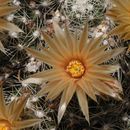en
names in breadcrumbs


Coryphantha missouriensis and its allies are diploid, except for the populations long known as Neobesseya similis (Engelmann) Britton & Rose, in the southeastern portion of the species’ range. Presently too few chromosome counts are available to allow satisfactory classification of the polyploids, which are larger in all parts but not always identifiable from morphology alone. The polyploids include some male-sterile plants, perhaps indicating some form of dioecy; their pollen grains display as much variation as the rest of the genus combined. Plants from Kansas and Oklahoma are especially morphologically ambiguous.
All parts including seeds, of Coryphantha missouriensis plants are generally larger in the Southwest (i.e., in Arizona) than northward. The neotenous populations in Navajo County, Arizona, are an exception, with the smallest individuals, shortest spines of the species. Both large and small extremes are diploid. The epithet marstonii [apparently based by L. D. Benson (1969) on C. vivipara] has been misapplied to the various Arizona and Utah populations of C. missouriensis, especially the peculiar plants in Navajo County, Arizona. In cultivation, the largest Arizona plants match dimensions of field-grown plants from proven tetraploid populations in central Texas; however, under the same greenhouse conditions the Texas plants become larger still, reaching the size of C. sulcata.
The fictional endemic Texas variety "var. robustior" [= Neobesseya wissmannii (Hildman ex K. Schumann) Britton & Rose] never corresponded to a populational entity. It evolved in the literature from robust individual plants in ordinary eastern populations, through misidentified plants of the sympatric C. sulcata, to inaccurate descriptions and maps based on mixtures of both species. Most published photographs captioned as "Neobesseya wissmannii" have portrayed misidentified plants of C. sulcata.
The closest relatives of Coryphantha missouriensis are C. asperispina Boedeker of Mexico and C. cubensis Britton & Rose of Cuba. Those species collectively composed the segregate genus Neobesseya, now rarely accepted.
Environmental degradation---introduced fire ants, suburban development, brush encroachment following fire suppression, and sometimes over-grazing---has extirpated Coryphantha missouriensis from many of its historically known sites. However, the vigorous polyploids rapidly colonize some disturbed habitats along with weedy species of Opuntia.
Escobaria missouriensis, the Missouri foxtail cactus and formerly Coryphantha missouriensis, is a species of low-growing North American cacti. It is found in along the Missouri River in the tallgrass prairie and shortgrass Great Plains, from Texas to Montana and the Dakotas, and in the Rocky Mountains woodlands of Ponderosa pine (Pinus ponderosa), pinyon-juniper, and Gambel oak (Quercus gambelii) west of it. It is also native to the Southwestern United States in Arizona, New Mexico, and Utah.[2][3][4]
Escobaria missouriensis grows up to 30 centimetres (12 in) high and forms clumps to 30 centimetres (12 in) or greater in diameter. They are generally larger in the Southwest. The plants are primarily unbranched, except eastern populations that can be profusely branched. The spines are bright white, pale gray, or pale tan, weathering to gray or yellowish brown.[2] The plant blooms in April to June, with flowers that are pale greenish yellow to yellow-green with midstripes of green or rose-pink to pale brown.[2][5]
Escobaria missouriensis has been extirpated from many of its historically known sites by introduced fire ants, suburban development, brush encroachment following fire suppression, and over-grazing.[2]
 Escobaria missouriensis var. asperispina - Missouri foxtail cactus
Escobaria missouriensis var. asperispina - Missouri foxtail cactus Escobaria missouriensis, the Missouri foxtail cactus and formerly Coryphantha missouriensis, is a species of low-growing North American cacti. It is found in along the Missouri River in the tallgrass prairie and shortgrass Great Plains, from Texas to Montana and the Dakotas, and in the Rocky Mountains woodlands of Ponderosa pine (Pinus ponderosa), pinyon-juniper, and Gambel oak (Quercus gambelii) west of it. It is also native to the Southwestern United States in Arizona, New Mexico, and Utah.